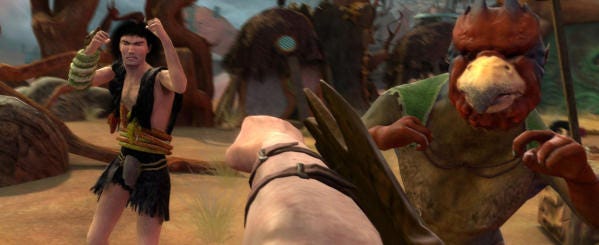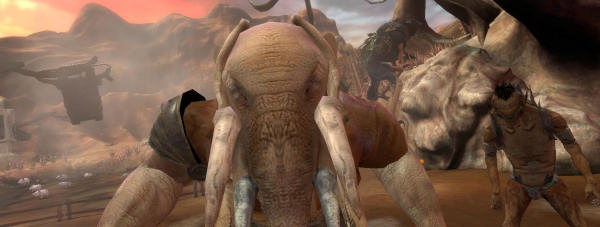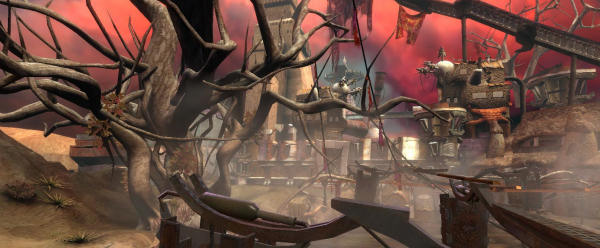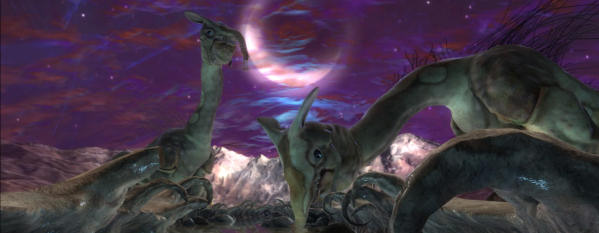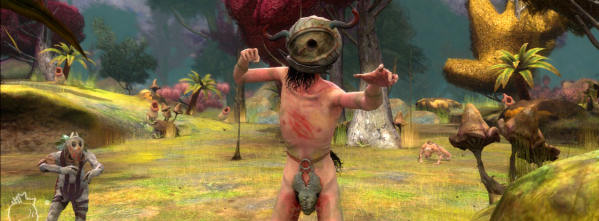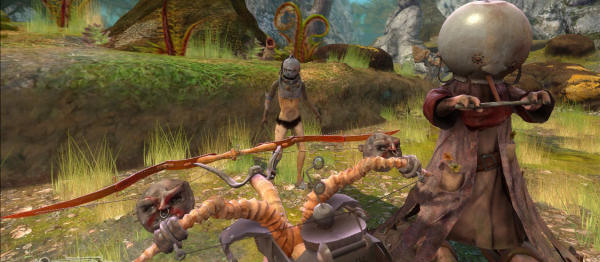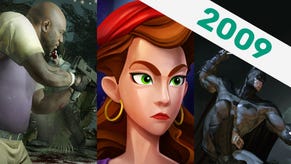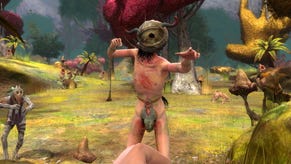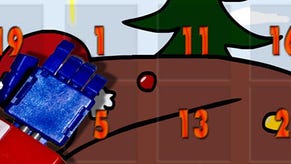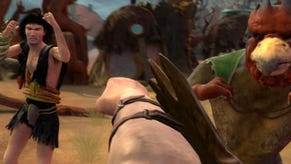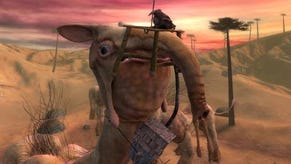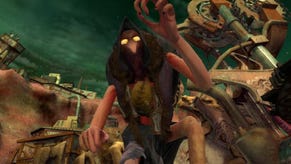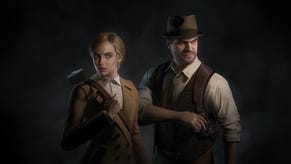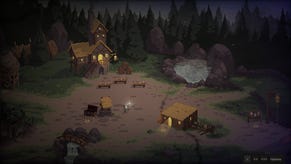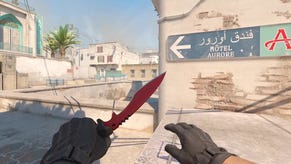Unknown Pleasures 2009: Zeno Clash
Zeno Clash is different. Which is refreshing. A melee-focused first-person game in the Source engine, in a world that doesn't look like anything else around. Which isn't a thing you get to say about many games. Nominated in the 2009 IGF Awards, the independent game from the start-up Chilean developer is rapidly gathering attention. We've had a preview of a few levels, and spoken to one of the founding members of the ACE Team, Edmundo Bordeu, which marvellously you'll find below.
The most important thing Zeno Clash has to get right is the melee combat. There's no question that they've nailed the art design (although some more colour balance is needed, the gorgeous backgrounds tend to be so colourful that spotting your enemy can be tricky), the voice acting is quite remarkably good, and even the weapons are completely novel. What will make or break it is how convincing the one-on-one fighting feels.
From our brief play, it's almost there. Dodging is still tricky, and getting hit has a surprisingly violent result, causing you to drop any weapon you might carry, stumble, and lose a chunk of health. (The game uses Mortal Kombat-style health bars at the top of the screen during fights). I think this might simply be a difficulty tweak - even on Easy it's a tad challenging. However, I can safely say I've never played a game in which I've beaten up an elephant with a hammer, or bashed someone's face into my knee quite so brutally, yet without it feeling icky. We intrigued, impressed this will be a $20 indie release, and wanted to find out more about the process of getting the game to this stage, and the challenges going forward. So we spoke to one of the founding brothers behind ACE Team, Edmundo Bordeu.
RPS: How did ACE Team come to be?
Edmundo Bordeu: ACE Team has been working as a company for about two years, but the name comes from much earlier. Initially “ACE” was the initials for Andres Carlos and Edmundo Bordeu and we used that name as a mod development team. The three of us are brothers, and we always wanted to make videogames.
We started by “modding” games in a Macintosh Plus (I put modding in quote marks because at the time the only thing we could do was change a few pixellated graphics). We did make other bigger mods, like a mod about Batman for Doom (Batman Doom), and an action-horror single player mod for Quake 3, called “The Dark Conjunction”.
In 2004 Andres and Carlos started working for Wanako Games, a Chilean company that specializes in casual games. There they met David Caloguerea, an excellent programmer. In 2007 the three of us together with David went independent so we could work on Zeno Clash. We always wanted to make our own original games, and that wasn’t going to happen while working in someone else’s company.
RPS: Are there many developers in Chile? It’s not a part of the world we’ve seen many games come from, beyond the non-New York half of Wanako Games.
EB: There are definitely not many developers in Chile. There are a couple of other game developers besides Wanako and ACE Team that work on mobile phone games or flash web games, and of course there are modders and videogame student projects just like anywhere else …but that’s about it.
RPS: Zeno Clash, from what we’ve seen of it, looks like an extremely bold and ambitious first game. What inspired the decision to make it?
EB: From the mods we have made you can guess we have a preference for the first person shooter genre. But also our favorites are the ones that change things a bit, like the Thief series, or System Shock.
We had already made a prototype of Zeno Clash during 2003 (at the time it was called ‘Zenozoik’). This game was probably too ambitious; it was supposed to have huge worlds, RPG elements like different character classes, problems that could be solved with multiple violent or non-violent solutions and a very incomplete first person melee combat system. Eventually we ended up with a demo which had a lot of things, but none of them were exceptional.
So years later, when we started reworking Zeno Clash we decided to focus on the coolest features of the game and on what we would be capable of producing as a starting independent game studio. Our top feature would be first person melee combat. It was a big decision to start producing Zeno Clash, so we made a demo in the Source engine and then we showed it to the people at Valve. They liked it and told us all we had to do was make the game and they would sell it on Steam. That is a very good start for a project, so at that point we knew we were on the right track.
RPS: The game has an amazingly unique look. Who’s responsible for the artistic direction, and how important has that been when developing the game?
EB: Andres, Carlos and I always work on the design and art areas. While we were making the demo we were still experimenting with the look of the game, but I had more time than them to make art assets, and I wrote the story, so I guess that is why later I became ‘art director’. But we all contributed to the look of the game.
I think giving the game a unique art direction has been one of the most important things for us. We didn’t want to make another war-inspired shooter or an ‘orcs and elves’ fantasy game, because there are thousands of other developers already doing that. One of the things we have always liked in games is how unique and strange the worlds can be, and personally, I have played some games just to see how the next level looks like. However, we felt the first person genre had a few “holes” in its diversity...
Last year I made a list of all the first person shooters that had been released recently, and found out that 50% were about wars or terrorism, 35% were about wars in space or with monsters, 3% were gun simulations, and only 10% explored all the other remaining possibilities. In 2007 even Turok became a space marine!
Our inspirations were Bosch's paintings and John Blanches ‘punk fantasy’ illustrations from the 80’s. It was something we really liked, but we had never seen in a game. Oh, and they have colors! Another thing we wanted to react to was the trend in gritty and monochromatic color palettes being used so often. Making a strange, even ugly world, sounds risky, but it has worked great for us.
RPS: Can you explain a bit about who Father-Mother is?
EB: Father-Mother, a huge part-bird part-human creature, is the main antagonist of the story. He/she is both father and mother of many of the characters in the game (including Ghat, the player character) and Father-Mother’s children are also very diverse; humanoids and animals of all kinds. In the land of Zeno Clash there are no kings, states or law enforcers, so the only forms of organized groups you find are gangs and families. Since Father-Mother has so many children he/she is the head of the most powerful group around.
Father-Mother always keeps many of his/her babies hidden inside his/her vest. Most people who test the game see Father-Mother and think he/she is a “creepy-monster” kind of character, and they often assume he/she eats the babies or something like that, but of course he/she doesn’t!
I suppose we often assume that ugly characters must do bad things, but Father-Mother loves all his/her children. Ghat is the one who will get in trouble with the rest of his family, disobeying Father-Mother, and starting the conflict which will be resolved in the game.
RPS: How important is the plot in the game? Where does the focus fall between action and story?
EB: The story is important in a single player adventure. People are curious about the strange world and characters we have created, but I guess they also want to finally make sense of what they are seeing. The plot is a big part of our game.
Zeno Clash is an action game, but at many points of the game there are scripted events or in-game cinematics. Cinematics are not the only way to tell a story in a game, but I think it is still one of the most effective.
We also try to follow this rule; any sequence which is about action and fighting is left for the player (and not a cinematic). Don’t you feel a bit cheated in a game when your character can do much cooler actions during cinematics than when you are playing as him?
RPS: Has Source been a natural fit for melee combat?
EB: I think Source is a good engine for a great variety of games. Source has so many tools available it helps a lot in development. The character animation and facial systems are the best I’ve ever used. For example; in Zeno Clash you can read your enemy’s attitude in his face, (whether he is in angry, scared or “bragging”. Emotions change a bit the way the enemies fight). The point is that we had time to add this feature only because the basic tools necessary to make it work were already there.
But no matter the engine, first person melee combat is something that had to be re-invented. Few FPSs have done melee combat, and they have always done it in different ways. Dark Messiah of Might and Magic also used the Source engine and has melee weapon combat, but it is still very different from what we are doing with Zeno Clash.
RPS: Melee is very rare in first-person games. Why do you think that is? And has it been a challenge to get it working?
EB:I don’t know why it hasn’t been done more often. It is something we wanted to have in our prototype in 2003, so I am surprised few people have tried it since then. Many exciting action moments happen when the enemies are close, so it makes perfect sense to have melee combat in a first person game.
But if we remember, some years ago characters who had feet were also rare in first person games, so maybe that was one of the reasons, because I think having an actual body in the game world is important to make convincing melee combat. How could you grab an enemy and kneebash his face if your avatar during gameplay is just a couple of arms?
That was the first challenge: To attach the camera to the eyes of a player model, which will animate and move when you perform any action, thus influencing the camera. Some people were worried that it would mean too much camera movement, and that players would get confused, but it doesn’t need to be that way. You simply don’t need to go for realism with the camera movement; the camera won’t mimic every single movement of the character’s head (because that would be annoying). We edit, stabilize or smooth camera movement by hand for every animation.
Another challenge was giving the combat system depth without making it too difficult to learn and control. One thing we did was create a lock-on system during melee combat. Locking your view frees you from the necessity to aim every single punch, and allows you to focus on other things of the combat system, like dodging, blocking and deflecting punches. Other games fix this by using a lot of auto-aiming for melee combat, but I don't think it was enough for Zeno Clash. We have changed the locking system a lot of times since the first version, and it has improved a lot thanks to the feedback from playtesters.
RPS: Do you believe there are risks when challenging your audience with something distinct and new?
EB: In videogame development there are always risks, but trying to innovate is definitely not the greater risk. When we submitted our “Zenozoik” demo some years ago to a scouting agency (which would then present it to publishers) one of the main questions they asked in their forms was “To what other game is your game similar?”, because they tried to predict how well a game would do by comparing it to other similar games. That would make them feel safe.
I disagree completely with this philosophy. As an antidote to this mindset I highly recommend the book “Funky Business” by Jonas Ridderstale and Kjell Nordstrom. In the book you can find many examples of how industries thrive on innovation, and that there is a far greater risk than making something distinct: and that’s to do what everyone else is doing.
Zeno Clash is due out in the next couple of months, available via Steam.
